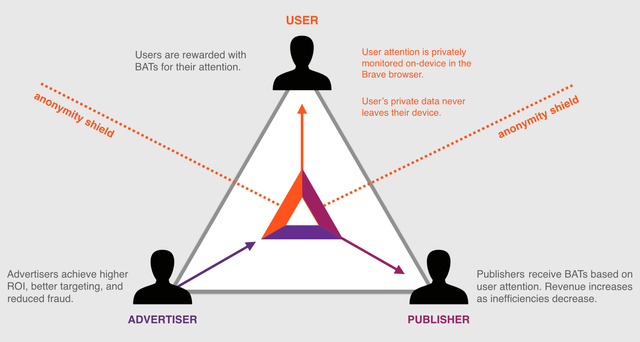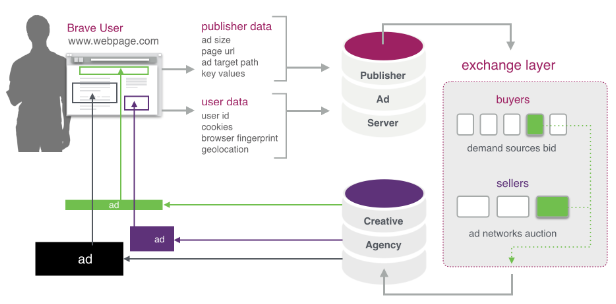Crypto Analysis Series - Part 1: Basic Attention Token and How It's Revolutionizing the Internet
Brief
BAT (Basic Attention Token) is a crypto-currency that aims to bridge the gaps between one of the fiercest business triangles: user, advertiser and publisher. It predominantly functions as a way for advertisers to pay publishers to put up advertisements on their websites. At this point, it doesn’t seem all that different from the traditionally used internet advertising process, but BAT dramatically changes the entire ‘publisher-advertiser-user’ dynamic in a way that will change the way people view online content.
After the recent listing on Coinbase, BAT has blown up with popularity. These days, a Coinbase listing announcement is followed by a huge pump in price. This has a lot to do with the fact that people who have been involved with the market for a while now know that Coinbase listings increase volumes. This is because new investors to the crypto-sphere tend to sign up, at least initially, with Coinbase. It is also one of the largest exchanges that launched more than a $300 million institutional crypto-currency fund. Leaving that aside, what exactly is BAT?
Functionality and Focus
To utilize the functions of BAT, a user must use the web browser developed by the BAT team i.e. Brave Browser. By default, Brave Browser disables trackers and blocks all ads. It has over 10 million downloads on the Google Play Store and innumerable desktop downloads. People are usually apprehensive about new browsers because they store and help access a lot of different information, some of which they would want to keep within the privacy of their own device. So what makes the Brave Browser ‘trustworthy’? The founder of BAT and Brave is Brendan Eich, the co-founder of Mozilla Firefox and the creator of JavaScript. His aim with this project is the same as most cryptocurrencies; to use distributed ledger technology to help secure people’s privacy as well give them an experience that is outside the bounds of traditional multimedia.
Brave, like any internet browser, does collect your user data. This does not mean that your data is directly sent to Brave, rather, it actually stores it locally and cryptographically secures it with Zero Knowledge Proofs (ZKP) to access your data solely for their main function- advertisements based on viewing history.
The objective of Brave is not to cut out advertisements. These are an incredibly important source of revenue for publishers or content creators. It actually helps improve the publisher’s ad revenue while making ads more individually oriented to each user. Let’s take the example of a hypothetical website, ‘www.xyz.com’. This website partners with Brave in order to receive BAT as compensation for broadcasting internet advertisements. At the same time, users using the Brave browser are shown advertisements based on their viewing history. So someone who regularly visits tech forums, YCombinator and technology news websites would see more advertisements from technology based companies. Somebody who constantly visits news outlets and views articles on football, goes to football team websites, and regularly streams matches will see a lot of sports based ads. So unlike today’s structure where advertisers are directly in business with publishers, all advertisers will be in business with all Brave publishing partners and their ads will be shown to people based on user preference.
This kind of structure from the outside seems like it deteriorates ad revenue for publishers, but it’s quite the opposite. Today, publishers have a fair amount of their total revenue going towards various expenses. This includes ad serving fees, operational fees, monitoring and analytics costs which are all paid to intermediary agencies. Brave and BAT together aim to eliminate the need for these middlemen, bring advertisers and content creators together with no central agency involved. Publishers today, because of these costs, have to clutter their website with advertisements in order to earn a decent revenue. This is why a lot of websites of varying sizes, from large news aggregators to independent blogs, are chaotic with advertisements running all over. With integration from BAT, publishers will have significantly reduced costs and advertisers will have higher revenues and returns on investment from user penetration of their real audience and targeting potential customers.
Privacy
More than just money, digital privacy is of utmost concern. After the Facebook and Google incidents and the implementation of GDPR in the EU, it has become quite apparent that we live in times of questionable privacy practices. When people talk about how the ordinary Joe has lost control of how much personal information companies collect of theirs, advertisements play a surprisingly important role. They have proven to be one of the largest resources for collecting user data. In the current scenario, user info first goes to a publisher. The publisher then send this user data as well as their own to an ad server run by a creative agency. Brave addresses this in a very simple yet efficient manner. With Brave, your data never leaves your device and is accessed only to help determine the kind of advertisements that are suited for you. The most important thing Brave does is scan ‘malvertisements’. These are advertisements with malicious code in them. When a user clicks on the ad, it downloads the malicious code onto their device and steals data. From 2015 to 2016, malvertisements were up by 132%. Despite this, no government agency thought it was time to regulate ads and put in some kind of stringent measures to make sure malicious activity was eradicated or at least reduced.
What Really Sets It Apart
All this seems quite fascinating and makes for a strong case to adopt the Brave browser, but the best is yet to come. The developers believe that there is one essential element missing from the puzzle. Publishers are rewarded for showcasing ads and advertisers are rewarded with increase in sales or brand image. But what about the group giving them all this power; the user. In today’s landscape, user attention is given no value despite being the driver of growth for both the advertiser and publisher. Brave rewards users for their attention by sharing a percentage of total revenue with the user. This means, by viewing the ads that are determined to be in line with your preferences, you will be paid a portion of BAT for your attention. This is the key element of BAT that I personally believe will the driving force that leads to people adopting it on a mass scale.
In the future, BAT will eventually be used to purchases digital products and services from publishers. This includes one-time payments like subscriptions or access as well as data services and various digital goods. Seeing as BAT is an ERC20 token that functions on the Ethereum blockchain, it can enable a smart contract to work as an escrow agency for these exchanges.
Key Elements
• Faster load time due to low bandwidth requirement and restricting data transfer from ads
• Uncluttered screen
• Advertisements as per user interest
• Malware detection capability
• Attention of users is rewarded and valued
• No middlemen leads to an efficient process for all those involved
• Increase in publisher revenues
• Exponentially increased privacy measures to make sure user data is protected
Image Sources
• Basic Attention Token
• Ethereum World News
Leave your suggestions below for cryptocurrencies you would like covered
Be a part of our Discord community
- AB



Your post had been curated by the @buildawhale team and mentioned here:
https://steemit.com/curation/@buildawhale/buildawhale-curation-digest-11-14-18
Keep up the good work and original content, everyone appreciates it!